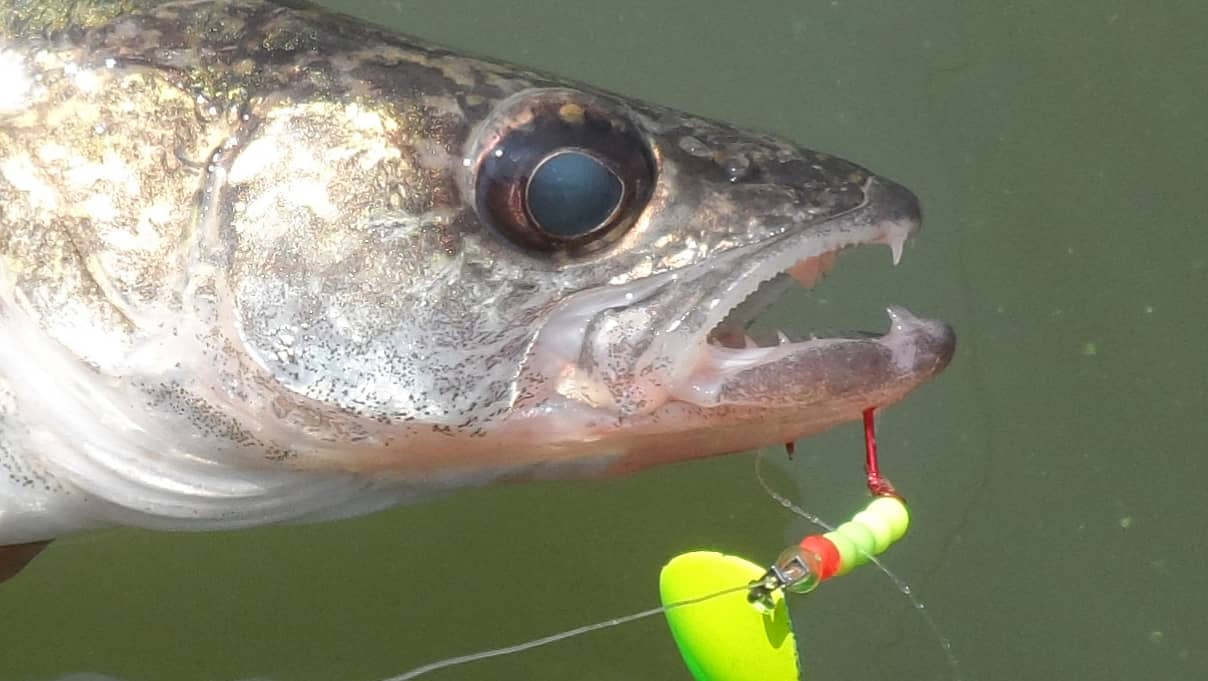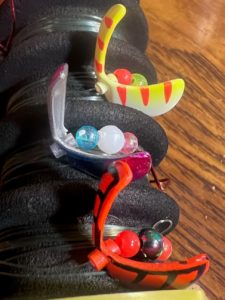
A Color Connection? What colors do walleyes see best, and are spinner assemblies of those patterns vital to success or are there other factors? Simonson Photo.
By Nick Simonson
The world is white again. Heading into a weekend where pastel eggs should be stashed in the crannies of a greening yard under blue skies and a yellow spring sun, nearly two feet of snow covers everything, and in the wind tunnels between houses along the block, arching slopes of white drift up toward the rooftops. It’s easy to once again appreciate color when Mother Nature makes good on her looming threat that whiteouts can happen well into the middle of spring in our region.

Less than a week ago, I was fishing in shorts, ripping a bright pink stickbait through the shallows for bass, and the following day pulling a holographic green-orange-and-crystal Shad Rap along the river channel for walleyes. While the latter experience was the colder of the two, it was still open water and with success, sparked in me ideas for more adventures chasing the walleyes below later in the spring. Those plans, while their immediacy may have been derailed somewhat by winter’s return, remain for the rest of the season. In the meantime, nothing helps fill the void like going over tackle and taking care of a few last projects to be sure I’m well prepared when those adventures resume.
To add more to the days of in-home confinement caused by the growing drifts outside (or perhaps delay my duties in clearing them out until conditions improved) I assembled a few walleye spinners and slow death rigs last evening, placing the brightly colored beads ahead of the hook with a variety of butterfly, Colorado and smile blades ahead of them. If nothing else, the bright springlike colors were a soothing sight as the patterns came together on my spinner rolls.
But those color combinations also got me thinking: do the bright hues of beads, or even the spinner blades on those creations even matter to walleyes? Would it just be easier to stack a bunch of white beads, or silver ones, or simply a float behind any old blade and that would be good enough to catch walleyes? While some of the need for color might just be in my own desire to see a nice lure, there are some aspects that trigger a reaction in walleyes, according to on the water experts and biologists.
“Reflective colors, bright colors and dull colors, as far as natural,” advises walleye fishing guide Kellen Latendresse in terms of the basic categories of colors he likes to pull for walleyes based on conditions and to determine daily fish preference, particularly for crankbaits, but the colored intricacies in lures are likely less important in the walleye fishing process, “I don’t think spinner beads are anything important…I think the vibration gets them there and they’re going there to eat the crawler or whatever you’ve got for bait.”
Biologically, walleyes can see color, even with their specialized eyes. Perhaps they cannot do so as strongly or as detailed as other fish species with eyes that are more generalized and akin to what we humans have, like largemouth bass, but walleyes can pick up a change in hue and see predominantly red, orange and green shades, much like a person with traditional color blindness according to studies.
As a result, those baits with chartreuse, green or emerald and bright oranges with a splash of red stand out, and other colors are likely sorted into those nearby color spectrums. Conditions under the water may also have quite a bit of influence on color selection, advises Todd Caspers, North Dakota Game & Fish Department Biologist on Devils Lake.
“The color [chosen] depends maybe on the water clarity too. In dingy water it’s better to have something a little flashier, a little easier for them to pick out. If it’s really clear water, something like just a silver would be better because it just imitates a baitfish flash. There’s a lot of intricacies to it,” advises, Caspers adding, “their eyes are always the same, it’s just if the water clarity is going to allow them to see very far.”
So, while on-the-water application and even science may not support the colorful assortment and patterning of the beads on a spinner, or perhaps even the blade’s hue either, confidence colors still come into play for many anglers. It’s tough to deny a successful pattern, such as chartreuse on a eutrophic reservoir, pink on a clear natural lake, or purple on a tannin-staned shield flow when those patterns have produced walleyes in the past.
Assembling spinners in those arrangements which have paid off, and likely will this season, at least paints a pleasant picture of what’s to come and adds a pop to the bleak exterior world right now.
